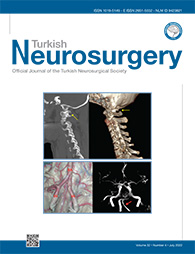2Arel University Faculty of Medicine, Department of Anatomy, Istanbul, Turkey
3Gaziosmanpasa University Faculty of Medicine, Department of Histology and Embrylogy, Tokat, Turkey
4Erciyes University Faculty of Medicine, Department of Histology and Embrylogy, Kayseri, Turkey
5Afyonkarahisar University of Health Sciences Faculty of Medicine, Department of Anatomy, Afyon, Turkey
6Erciyes University Faculty of Medicine, Department of Neurology, Kayseri, Turkey
7Erciyes University Faculty of Engineering, Department of Electrical Electronics Engineering, Kayseri, Turkey DOI : 10.5137/1019-5149.JTN.35313-21.2 AIM: To evaluate the impact of carnosine on Purkinje neurons in rats exposed to a 900 Mhz electromagnetic field.
MATERIAL and METHODS: This study evaluated 24 rats divided into the following three different groups: a control group, a group exposed to the electromagnetic field, and a group that was injected with carnosine while being exposed to the electromagnetic field. The electromagnetic field group was exposed to a 900 Mhz electromagnetic field for an hour daily over 28 days. Thereafter, stereological analysis was performed histologically on cerebellar sections, and the number of Purkinje cells were counted.
RESULTS: The electromagnetic field group had remarkably fewer Purkinje cell compared to control. The electromagnetic field group plus 20 mg of carnosine had significantly more total Purkinje cells compared to the electromagnetic field group (p<0.05).
CONCLUSION: The present study showed that electromagnetic field exposure decreases the number of Purkinje cell, whereas carnosine protected the cerebellum from neural damage induced by electromagnetic field exposure.
Keywords : Carnosine, Cerebellum, Electromagnetic field, Purkinje cell, Stereology, Rats




